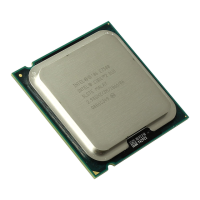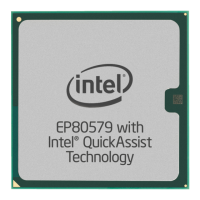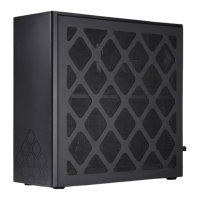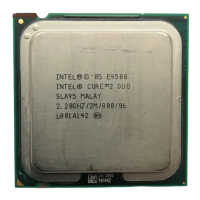Do you have a question about the Intel ETHEREXPRESS PRO/100 and is the answer not in the manual?
Provides an introduction to the hardware installation chapter.
Explains the 56K modem technology used by the PRO/100 PC Card.
Details the specific model number of the PRO/100 PC Card.
Information on supplied software and additional features of the card.
Describes the HotSwap and power management features.
Instructions for unpacking and inspecting the hardware components.
Lists package contents and other required equipment for setup.
Step-by-step guide for installing the card into the PC slot.
Guides the user on identifying the specific version of Windows 95.
Provides an overview and important notes for retail version installation.
Details the recommended steps for insertion, detection, and disk prompts.
Instructions for performing network installation in Windows 95.
Provides an overview and important notes for OSR2 installation.
Offers troubleshooting tips, including device conflict resolution.
Reference for driver parameters specific to Windows 95.
Information on identifying the correct version of Windows NT.
Detailed steps for installing the PC Card under Windows NT 4.0.
Instructions for setting up the modem component.
Detailed steps for installing the PC Card under Windows NT 3.51.
Reference for driver parameters specific to Windows NT.
Instructions for installing the card under MS-DOS.
Steps for installing under Windows 3.x and Windows for Workgroups.
Alphabetical reference for Windows 3.x network operating systems.
Guides for installing drivers for various network software.
Important notes for configuring modem drivers in Windows 3.x.
Details on managing COM ports, IRQs, and I/O base addresses.
Procedures for modifying interrupt and I/O address settings.
Strategies and methods for preventing memory conflicts.
Configuration settings for Windows 3.x modem drivers.
Parameters for various network drivers in Windows 3.x.
Common error messages encountered with Windows 3.x and DOS drivers.
Troubleshooting common issues within the Windows 3.x environment.
Steps to resolve issues when the driver loads but network access fails.
Resolving problems with DOS modem software functionality.
Troubleshooting modem functionality differences between DOS and Windows.
Utility to set country-specific modem settings.
Tool for diagnosing and testing the modem's functionality.
A diagnostic program for self-testing the PC Card.
Details on the functions available within the diagnostic utility.
A monitor utility for COM ports specifically for Windows 3.x.
Notes and script files for popular communications programs.
Steps to set up the modem with various communications applications.
Instructions for configuring the modem post-Windows 95 setup.
Configuration details for America Online versions.
Setup instructions for CompuServe WINCIM application.
Configuration details for LapLink application.
Configuration instructions for Lotus cc:Mail Mobile.
Configuration details for Lotus Notes application.
Network setup for Microsoft Dial-Up Adapter in Windows 95.
Instructions for setting up Microsoft Remote Access Server.
Configuration steps for Prodigy Internet service.
Explanation of modem result codes.
Comprehensive reference for AT commands.
Details on special AT commands and escape sequences.
AT commands for answering and selecting communication standards.
AT commands for carrier control and dialing telephone numbers.
Reference for various dial modifiers used with AT commands.
AT commands related to echo control and switch hook options.
AT commands for requesting ID information and speaker control.
AT commands for negotiation options and result code display.
AT commands for pulse dialing and result code format options.
AT commands for negotiation progress and call progress options.
AT commands for disconnect options and recalling stored profiles.
AT commands for Data Carrier Detect (DCD) and Data Terminal Ready (DTR).
AT commands for loading factory settings and guard tone selection.
AT commands for flow control and asynchronous communications mode.
AT commands for asynchronous mode and self-test functions.
AT commands to view/write profiles and store telephone numbers.
AT commands for break control and error mode selection.
AT commands for local flow control and inactivity timer limits.
AT commands for viewing blacklists and data compression control.
AT command to control data calling tone.
AT commands for requesting capabilities and setting country of installation.
AT commands for requesting identification and selecting modulation.
Reference guide for S-registers.
Provides an introduction to the modem's S-registers.
Details on S-registers for ringing, counting, and escape characters.
S-registers for response formatting, editing, and dialing waits.
S-registers controlling connection timeouts and dial modifier pause duration.
S-registers for DTMF tone duration, escape guard time, and modulation.
S-registers for inactivity timer and DTE throughput limits.
S-registers for data calling tone and negotiation fallback.
S-registers for dial line rate and ETC startup autorating.
S-registers for auto rate and auto mode selection.
S-registers for data compression and LAPM error control negotiation.
S-registers for sleep mode timer and line transmit level.
S-registers for connect transmit level and negotiation message options.
S-registers for cable detection options.
Information on accessing Intel support via WWW, FTP, and BBS.
List of official Intel web and internet site addresses.
Details on how to contact Intel customer support technicians.
Physical and environmental specifications of the PC Card.
Detailed technical specifications of the modem functionality.
Procedure for returning a defective product for warranty service.
FCC compliance statement for radio frequency emissions.
FCC compliance statement for telephone network connection.
Industry Canada compliance statement for digital apparatus.
Manufacturer's declaration regarding product testing and requirements.
Provides an introduction to the hardware installation chapter.
Explains the 56K modem technology used by the PRO/100 PC Card.
Details the specific model number of the PRO/100 PC Card.
Information on supplied software and additional features of the card.
Describes the HotSwap and power management features.
Instructions for unpacking and inspecting the hardware components.
Lists package contents and other required equipment for setup.
Step-by-step guide for installing the card into the PC slot.
Guides the user on identifying the specific version of Windows 95.
Provides an overview and important notes for retail version installation.
Details the recommended steps for insertion, detection, and disk prompts.
Instructions for performing network installation in Windows 95.
Provides an overview and important notes for OSR2 installation.
Offers troubleshooting tips, including device conflict resolution.
Reference for driver parameters specific to Windows 95.
Information on identifying the correct version of Windows NT.
Detailed steps for installing the PC Card under Windows NT 4.0.
Instructions for setting up the modem component.
Detailed steps for installing the PC Card under Windows NT 3.51.
Reference for driver parameters specific to Windows NT.
Instructions for installing the card under MS-DOS.
Steps for installing under Windows 3.x and Windows for Workgroups.
Alphabetical reference for Windows 3.x network operating systems.
Guides for installing drivers for various network software.
Important notes for configuring modem drivers in Windows 3.x.
Details on managing COM ports, IRQs, and I/O base addresses.
Procedures for modifying interrupt and I/O address settings.
Strategies and methods for preventing memory conflicts.
Configuration settings for Windows 3.x modem drivers.
Parameters for various network drivers in Windows 3.x.
Common error messages encountered with Windows 3.x and DOS drivers.
Troubleshooting common issues within the Windows 3.x environment.
Steps to resolve issues when the driver loads but network access fails.
Resolving problems with DOS modem software functionality.
Troubleshooting modem functionality differences between DOS and Windows.
Utility to set country-specific modem settings.
Tool for diagnosing and testing the modem's functionality.
A diagnostic program for self-testing the PC Card.
Details on the functions available within the diagnostic utility.
A monitor utility for COM ports specifically for Windows 3.x.
Notes and script files for popular communications programs.
Steps to set up the modem with various communications applications.
Instructions for configuring the modem post-Windows 95 setup.
Configuration details for America Online versions.
Setup instructions for CompuServe WINCIM application.
Configuration details for LapLink application.
Configuration instructions for Lotus cc:Mail Mobile.
Configuration details for Lotus Notes application.
Network setup for Microsoft Dial-Up Adapter in Windows 95.
Instructions for setting up Microsoft Remote Access Server.
Configuration steps for Prodigy Internet service.
Explanation of modem result codes.
Comprehensive reference for AT commands.
Details on special AT commands and escape sequences.
AT commands for answering and selecting communication standards.
AT commands for carrier control and dialing telephone numbers.
Reference for various dial modifiers used with AT commands.
AT commands related to echo control and switch hook options.
AT commands for requesting ID information and speaker control.
AT commands for negotiation options and result code display.
AT commands for pulse dialing and result code format options.
AT commands for negotiation progress and call progress options.
AT commands for disconnect options and recalling stored profiles.
AT commands for Data Carrier Detect (DCD) and Data Terminal Ready (DTR).
AT commands for loading factory settings and guard tone selection.
AT commands for flow control and asynchronous communications mode.
AT commands for asynchronous mode and self-test functions.
AT commands to view/write profiles and store telephone numbers.
AT commands for break control and error mode selection.
AT commands for local flow control and inactivity timer limits.
AT commands for viewing blacklists and data compression control.
AT command to control data calling tone.
AT commands for requesting capabilities and setting country of installation.
AT commands for requesting identification and selecting modulation.
Reference guide for S-registers.
Provides an introduction to the modem's S-registers.
Details on S-registers for ringing, counting, and escape characters.
S-registers for response formatting, editing, and dialing waits.
S-registers controlling connection timeouts and dial modifier pause duration.
S-registers for DTMF tone duration, escape guard time, and modulation.
S-registers for inactivity timer and DTE throughput limits.
S-registers for data calling tone and negotiation fallback.
S-registers for dial line rate and ETC startup autorating.
S-registers for auto rate and auto mode selection.
S-registers for data compression and LAPM error control negotiation.
S-registers for sleep mode timer and line transmit level.
S-registers for connect transmit level and negotiation message options.
S-registers for cable detection options.
Information on accessing Intel support via WWW, FTP, and BBS.
List of official Intel web and internet site addresses.
Details on how to contact Intel customer support technicians.
Physical and environmental specifications of the PC Card.
Detailed technical specifications of the modem functionality.
Procedure for returning a defective product for warranty service.
FCC compliance statement for radio frequency emissions.
FCC compliance statement for telephone network connection.
Industry Canada compliance statement for digital apparatus.
Manufacturer's declaration regarding product testing and requirements.
| Device Type | Network adapter |
|---|---|
| Form Factor | Plug-in card |
| Data Link Protocol | Ethernet, Fast Ethernet |
| Data Transfer Rate | 100 Mbps |
| Compliant Standards | IEEE 802.3, IEEE 802.3u |
| Connector Type | RJ-45 |
| Bus Type | PCI |
| Chipset | Intel 82557 |
| Full Duplex Support | Yes |
| Wake-on-LAN Support | Yes |
| Ports | 1 x RJ45 |
| Data Rate | 10 Mbps / 100 Mbps |
| Operating Systems Supported | Linux, Windows |












